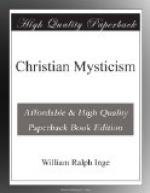The history of the word begins in close connexion with the Greek mysteries.[3] A mystic [Greek: mystes] is one who has been, or is being, initiated into some esoteric knowledge of Divine things, about which he must keep his mouth shut ([Greek: myein]); or, possibly, he is one whose eyes are still shut, one who is not yet an [Greek: epoptes].[4] The word was taken over, with other technical terms of the mysteries, by the Neoplatonists, who found in the existing mysteriosophy a discipline, worship, and rule of life congenial to their speculative views. But as the tendency towards quietism and introspection increased among them, another derivation for “Mysticism” was found—it was explained to mean deliberately shutting the eyes to all external things.[5] We shall see in the sequel how this later Neoplatonism passed almost entire into Christianity, and, while forming the basis of mediaeval Mysticism, caused a false association to cling to the word even down to the Reformation.[6]
The phase of thought or feeling which we call Mysticism has its origin in that which is the raw material of all religion, and perhaps of all philosophy and art as well, namely, that dim consciousness of the beyond, which is part of our nature as human beings. Men have given different names to these “obstinate questionings of sense and outward things.” We may call them, if we will, a sort of higher instinct, perhaps an anticipation of the evolutionary process; or an extension of the frontier of consciousness; or, in religious language, the voice of God speaking to us. Mysticism arises when we try to bring this higher consciousness into relation with the other contents of our minds. Religious Mysticism may be defined as the attempt to realise the presence of the living God in the soul and in nature, or, more generally, as the attempt to realise, in thought and feeling, the immanence of the temporal in the eternal, and of the eternal in the temporal. Our consciousness of the beyond is, I say, the raw material of all religion. But, being itself formless, it cannot be brought directly into relation with the forms of our thought. Accordingly, it has to express itself by symbols, which are as it were the flesh and bones of ideas. It is the tendency of all symbols to petrify or evaporate, and either process is fatal to them. They soon repudiate their mystical origin, and forthwith lose their religious content. Then comes a return to the fresh springs of the inner life—a revival of spirituality in the midst of formalism or unbelief. This is the historical function of Mysticism—it appears as an independent active principle, the spirit of reformations and revivals. But since every active principle must find for itself appropriate instruments, Mysticism has developed a speculative and practical system of its own. As Goethe says, it is “the scholastic of the heart, the dialectic of the feelings.” In this way it becomes possible to consider it as a type of religion, though it must always be remembered that in becoming such it has incorporated elements which do not belong to its inmost being.[7] As a type of religion, then, Mysticism seems to rest on the following propositions or articles of faith:—




